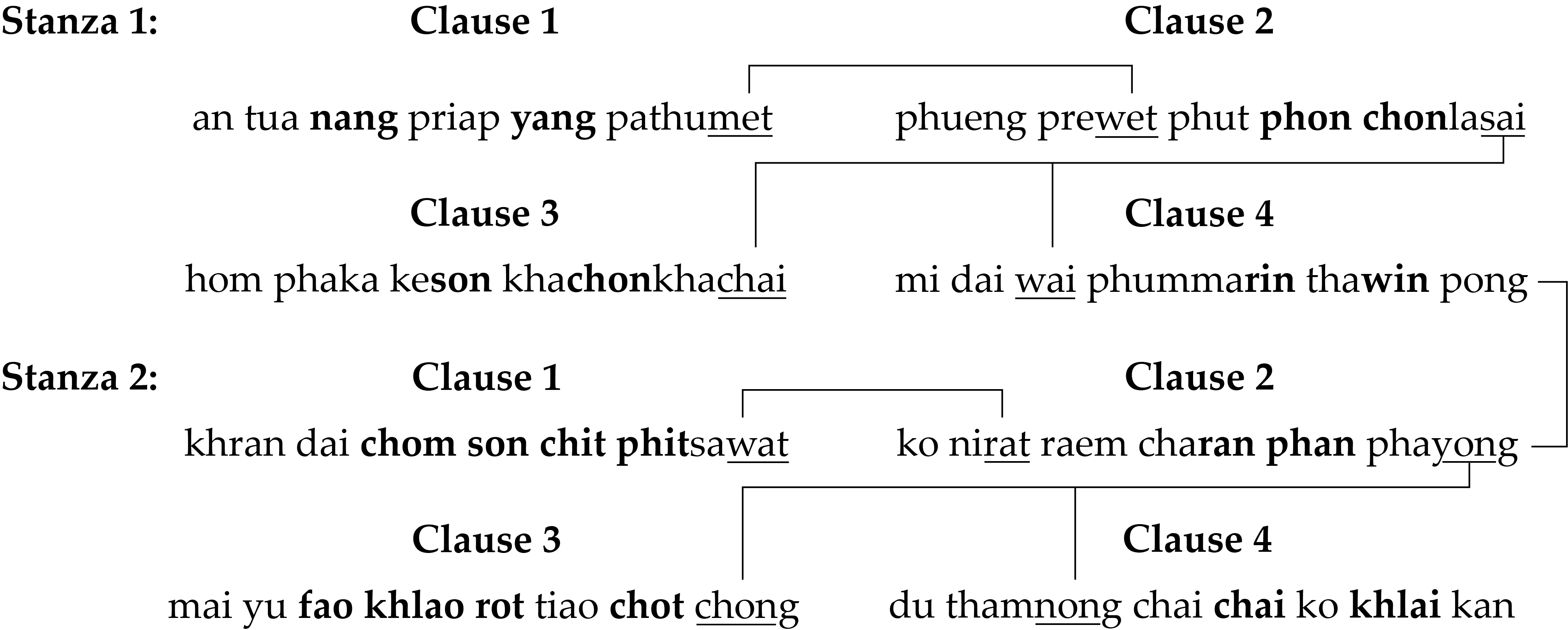
Peeriya Pongsarigun; John Viano
on translating Sunthorn Phu
Originally, “Preaching to Women” (composed between 1837–1840) was written as an epic poem that used the popular Thai rhyme scheme, klon suphap. In the klon suphap rhyme scheme, each line consists of seven to nine syllables. Further, each stanza has two lines, each line is divided into two clauses, and the last syllable of the first stanza must rhyme with the last syllable of the second line of the next stanza (see the diagram below). Also, there is a complex set of additional rhymes:
- The last syllable of the first clause must rhyme with the third syllable of the second clause.
- The last syllable of the second clause must rhyme with the last syllable of the third clause and the third syllable of the fourth clause.
Sunthorn Phu’s signature scheme of internal rhyming (indicated in bold in the diagram below) is complicated, though not compulsory to the klon suphap rhyme scheme, and achieved by rhyming the syllables within each clause as opposed to just rhyming across clauses, as discussed earlier. We faced the issue of helping the English-speaking ear properly perceive the rhyme, as the radically different and complex rhyme scheme present in Thai is difficult for non-native speakers to pick up.
We solved this problem by making the English version parallel wherever we could, using if-clauses and imperatives so that the translation read smoothly and beautifully. In doing so, we also managed to preserve the literary comparisons used in the original — i.e. comparing women to flowers and men to bees.
about the author
Sunthorn Phu (1786–1855), often called “Thailand’s Shakespeare,” lived during the Rattanakosin Period between the reigns of King Rama I and King Rama IV. He was famous for his epic poetry and memoirs. He was the first to use internal rhymes in Thai poetry, and the device became his signature. In 1986, he was honored by UNESCO as a world poet and Thai children study his poems to this day.
Sunthorn Phu flourished during the reign of King Rama II because Rama II loved literature and poetry. However, King Rama III, who emphasized trade and the economy, was uninterested in Phu’s work and offended by his pride and arrogance. Rama III’s reign, then, corresponds to Phu’s dark period. Phu returned to popularity during the reign of King Rama IV, who was also a poet.
We decided to translate “Preaching to Women” because it discusses traditional relationships between gender and power, and also to increase awareness and access to the works of one of Thailand’s most talented authors (Amazon has only one listing for Phu’s work).
about the translators
Peeriya and John are award-winning authors and translators who excel in creating English language rhyme schemes which echo that of their sources, while also accurately communicating the author’s message.
In 2019, their passion for literature and language led to their co-founding InterThaiMedia LLC to create media that bring people together across languages and cultures. InterThaiMedia’s first project will be a picture book called Can You Carry Me?, which is slated to be published in English, Spanish, and dual-language formats.
Altogether, Peeriya and John have translated song lyrics, poetry, and more than 140 children’s books. They last published with DoubleSpeak in Spring 2019.

